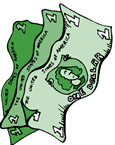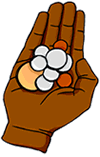Economic Spotter: Money in Revolutionary Times

Students take a trip back in time and spot economic concepts in a historical fiction tale. This time frame features Valley Forge in 1778. Take a look at the money used by the patriots and find out why some money couldn’t buy a dime!
Introduction
 What does money look like? What is it worth? Can we take our money to other countries and spend it? What did our money look like a long time ago? To explore these questions, you are going to travel in a time machine back to Valley Forge in 1778. Your job is to be an economic spotter and see if you can discover why some money could not be spent back then. If you couldn't spend it, is it money? That's an economic mystery!
What does money look like? What is it worth? Can we take our money to other countries and spend it? What did our money look like a long time ago? To explore these questions, you are going to travel in a time machine back to Valley Forge in 1778. Your job is to be an economic spotter and see if you can discover why some money could not be spent back then. If you couldn't spend it, is it money? That's an economic mystery!
Learning Objectives
- Know that most countries create their own currency for use as money.
- Understand that money is anything widely accepted as final payment for goods and services.
- Compare Continental Congress money with a Spanish half dollar. They should specifically refer to the purposes (functions) of money.
- Write an explanation telling which money they would want to have if they were living in Valley Forge, 1778.
Resource List
-
U.S. Mint Time Machine Activity: This website contains information about current and past coins and includes coin related activities.
www.usmint.gov/kids/timeMachine/
-
The History of Money:
https://www.frbatlanta.org/about/tours/story-of-money.aspx
-
50 State Quarters Program: This page on the U.S. Mint website provides information on the 50 state quarters program as well as images of each states quarter.
https://www.usmint.gov/learn/kids/coins-and-medals/50-state-quarters
-
Colonial and Continental Currencies: Images of Colonial and Continental Currencies
https://www.frbsf.org/education/teacher-resources/american-currency-exhibit/independence/
Process
People have used many different items for money including seashells, beads, tea, fish hooks, fur, cattle. As long as both parties accepted these items in trade, everything was fine–although paying someone in cattle is pretty messy if you need change! Practical difficulties of this sort prompted people to devise better forms of money.
 People in different countries tried different things. Coins were made and traded. That worked pretty well because the coins were made with valuable metals and were worth the amount of gold and silver they were made with.
People in different countries tried different things. Coins were made and traded. That worked pretty well because the coins were made with valuable metals and were worth the amount of gold and silver they were made with.
Paper money was a different story. It was made with paper, obviously, and paper was not very valuable. It was called REPRESENTATIVE money and it REPRESENTED a certain valuable item, like gold or silver. REPRESENTATIVE money was a lot easier to carry than what it represented!
At one time paper money represented tobacco leaves in United States. It was a lot easier to carry around than those big tobacco leaves! Do you think the "tobacco note" would have been accepted in Europe? [Probably not, because there would not have been a way to trade it in for the valuable tobacco. However, if Europeans could have found another party that would accept tobacco notes, then they could have used such notes in transactions.]
After people started to accept paper money, governments started to issue the currency and declared it to be legal. "Fiat money" is money declared by a government to be valid.
 Countries create their own money. Even though Canada uses dollars, and the United States uses dollars, those dollars look different. The dollar of Canada is issued in Canada and it is accepted everywhere in Canada. The United States dollar is issued in the United States and is accepted everywhere in the United States. When you leave the United States and enter Canada, you need to exchange your United States dollars for Canadian dollars if you want to shop, buy gas, or eat in a restaurant. Then when you return to the United States, you need to exchange your Canadian money for American money so that you can buy goods and services here.
Countries create their own money. Even though Canada uses dollars, and the United States uses dollars, those dollars look different. The dollar of Canada is issued in Canada and it is accepted everywhere in Canada. The United States dollar is issued in the United States and is accepted everywhere in the United States. When you leave the United States and enter Canada, you need to exchange your United States dollars for Canadian dollars if you want to shop, buy gas, or eat in a restaurant. Then when you return to the United States, you need to exchange your Canadian money for American money so that you can buy goods and services here.
At one time in America, people used money of all kinds, from different countries, and the money issued in America was not accepted! If it was not accepted, was it money? Let's look at the purposes, or functions, of money.
Money serves these three purposes (functions):
- Money is a "Medium of Exchange." That means people accept money in trade for goods and services. You cannot take play money and buy your school lunch, because the cafeteria won't accept it. You can't put play money in a vending machine and get a snack because the machine won't take your play coins. Money is money only when both parties will accept it as a trade.
- Money provides a "Standard of Value." That means that you can use money to measure the value of an item. A video game that costs $40 takes twice as much money to buy as a $20 video tape. That only makes sense! But what if our money didn't provide a standard of value? We would not be able to compare prices and find the best buy!
- Money also provides a "Store of Value." This means that you can save your money and use it in the future–its value will still be there. Wouldn't it be horrible if one day someone told you that no stores or banks would accept your pennies? What about all that money in your piggy bank?
 Now that you know all about the functions of money, let's see what purposes money served at Valley Forge during the Revolutionary War.
Now that you know all about the functions of money, let's see what purposes money served at Valley Forge during the Revolutionary War.
Go to the time machine website and think about the money you hear about in the story.
[NOTE: Click on the following link for a longer explanation of the history of money .]
Conclusion
At Valley Forge, the Continental wasn't a medium of exchange. This lesson teaches us that, for any item, if people accept it as money, if it has a standard of value, and if it can be saved and used in the future, then it is performing the functions that money should perform and it can be counted as money.
Extension Activity
Click on the following link for more information about the https://www.usmint.gov/learn/kids/coins-and-medals/50-state-quarters.
Check out the following link for images of https://www.frbsf.org/education/teacher-resources/american-currency-exhibit/independence/.
Go back to the time machine website. This time, click on "Time Trackers" to discover the different kinds of money used in the story (plus other historical facts).
Assessment
Students will write a paragraph explaining which coin, the Continental Congress money or the Spanish Half Dollar, they would prefer if you were living in Valley Forge, 1778; the explanation should include three reasons the preference stated, specifically referring to the purposes of money.